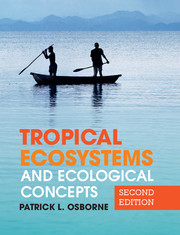Book contents
- Frontmatter
- Contents
- Preface
- Abbreviations and units
- Chapter 1 The tropical environment and climate
- Chapter 2 Dry, hot deserts and environmental factors
- Chapter 3 Grasslands and primary production
- Chapter 4 Savanna and population dynamics
- Chapter 5 Lakes, energy flow and biogeochemical cycling
- Chapter 6 Rivers, floodplains and estuaries
- Chapter 7 Wetlands and succession
- Chapter 8 Tropical rain forests and biodiversity
- Chapter 9 Mountains, zonation and community gradients
- Chapter 10 Mangroves, seagrasses and decomposition
- Chapter 11 Coral reefs and community ecology
- Chapter 12 Islands, archipelagos, biogeography and evolutionary ecology
- Chapter 13 Cities and human ecology
- Glossary
- References
- Index
- References
Chapter 5 - Lakes, energy flow and biogeochemical cycling
Published online by Cambridge University Press: 05 June 2012
- Frontmatter
- Contents
- Preface
- Abbreviations and units
- Chapter 1 The tropical environment and climate
- Chapter 2 Dry, hot deserts and environmental factors
- Chapter 3 Grasslands and primary production
- Chapter 4 Savanna and population dynamics
- Chapter 5 Lakes, energy flow and biogeochemical cycling
- Chapter 6 Rivers, floodplains and estuaries
- Chapter 7 Wetlands and succession
- Chapter 8 Tropical rain forests and biodiversity
- Chapter 9 Mountains, zonation and community gradients
- Chapter 10 Mangroves, seagrasses and decomposition
- Chapter 11 Coral reefs and community ecology
- Chapter 12 Islands, archipelagos, biogeography and evolutionary ecology
- Chapter 13 Cities and human ecology
- Glossary
- References
- Index
- References
Summary
In chapter 3, we saw how terrestrial plants accumulate organic matter through photosynthesis and how this process converted light energy into chemical energy. This chapter describes photosynthesis in aquatic plants and we follow the fate of energy fixed by plants (primary producers), its utilisation by animals (consumers or secondary producers), and the changes in energy that occur as this energy flows along a food chain. Unlike the one-way flow of energy, nutrients cycle from abiotic reservoirs (e.g. soil, sediment, atmosphere) into plants and animals, and through decomposition (which we will discuss in chapter 10) are returned to an abiotic reservoir. In chapter 2, we saw that most terrestrial plants obtain nutrients from soil. Nutrients enter aquatic systems from the atmosphere and in the water that drains their catchment areas. The supply of these nutrients to rivers (see chapter 6) and lakes is a major determinant of biological productivity and excess nutrient income to lakes may cause a suite of mostly adverse changes in a process known as eutrophication.
We have seen that seasonal changes significantly influence ecological processes in grasslands and savannas (chapters 3 and 4). Although the most obvious change in a tropical lake through the year might be a rise and fall in water level, significant seasonal changes also occur beneath the surface of deep lakes which have profound effects on lake ecology. These changes come about through seasonal shifts in water density with depth, resulting from changes in water temperature. The process varies from lake to lake, as examples described below show, but in tropical lakes it commonly consists of an annual alternation of layering, or thermal stratification, of the water column with a period of mixing.
- Type
- Chapter
- Information
- Tropical Ecosystems and Ecological Concepts , pp. 142 - 203Publisher: Cambridge University PressPrint publication year: 2012
References
- 1
- Cited by



